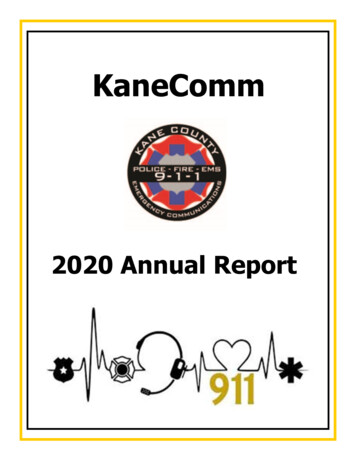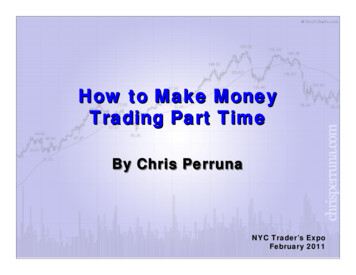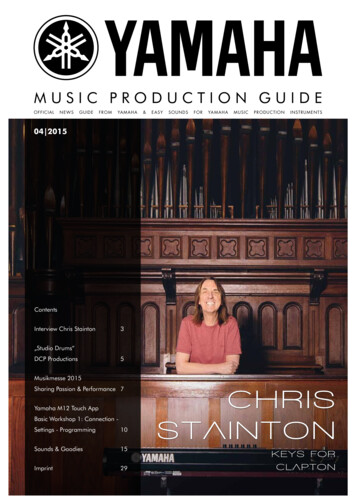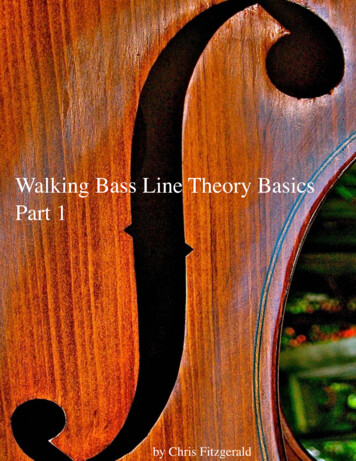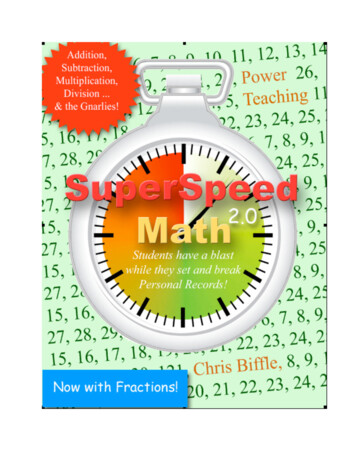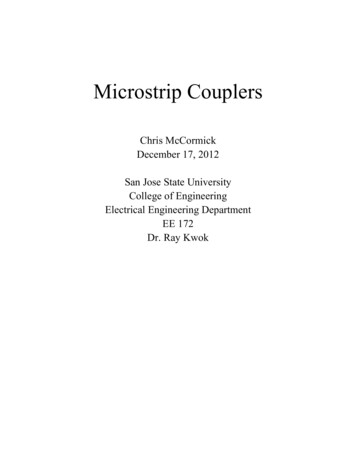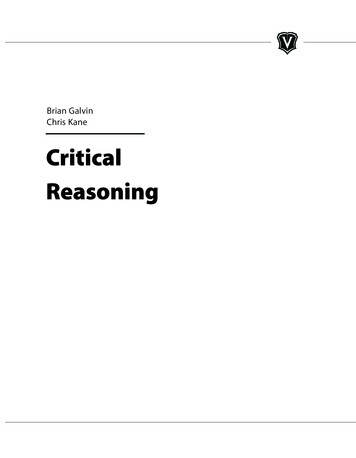
Transcription
Brian GalvinChris KaneCriticalReasoning
AuthorsBrian GalvinChris KaneCo-foundersMarkus MobergChad TroutwineContributing WritersDavid NewlandAshley Newman-OwensAaron PondBill RobinsonContributing EditorJodi BrandonCover DesignNick MasonInterior DesignTom AhnDennis AndersonALL RIGHTS RESERVED. Printed in the U.S.A.Third Edition, Copyright 2018 by Veritas Prep, LLC.GMAT is a registered trademark of the Graduate ManagementAdmission Council, which is not affiliated with this book.No part of this publication may be reproduced, stored ina retrieval system, or transmitted in any form or by anymeans, electronic, mechanical, photocopying, recording, orotherwise without the prior written permission of VeritasPrep, LLC.All the materials within are the exclusive property of VeritasPrep, LLC. 2018.Print Batch 2018.1
This book is dedicated to Veritas Prep’s instructors, whose enthusiasm and experiencehave contributed mightily to our educational philosophy and our students’ success.It is also dedicated to the teachers who inspired Veritas Prep’s instructors. The lessonthat follows was only made possible by a lifelong love of learning and of undertakingeducational challenges; we have teachers around the world to thank for that.Finally and most importantly, this book is dedicated to our thousands of students, whohave taught us more about teaching and learning than they will ever know. And to you,the reader, thank you for adding yourself to that group.Personal DedicationsVeritas Prep is a community of educators, students, and support staff, and these bookswould not be possible without our cast of thousands. We thank you all, but would liketo specifically acknowledge the following people for their inspiration:Clay Christensen (Harvard Business School), Tom Cotner (Plymouth-Salem HighSchool), David Cromwell (Yale School of Management), Lenore Goshorn(Allen Elementary School), Henry Grubb (Fort Osage High School), Dana Jinaru(Beat the GMAT), Patricia Kenney (University of Michigan), Steven Levitt(University of Chicago), Walter Lewin (Massachusetts Institute of Technology),Lawrence Rudner (Graduate Management Admission Council), Jeff Stanzler(University of Michigan), and Robert Weber (Kellogg School of Management).
TABLE OF CONTENTSLESSON PREVIEW . . . . . . . . . . . . . . . . . . . . . . . . . . . . . . . . . . . . . . . . . . . . . . . . . . . . . . . . . 7SKILLBUILDER . . . . . . . . . . . . . . . . . . . . . . . . . . . . . . . . . . . . . . . . . . . . . . . . . . . . . . . . . . . 13LESSON: INTRODUCTION TO CRITICAL REASONING . . . . . . . . . . . . . . . . . . . . . . . . 21Why Does the GMAT Test Critical Reasoning Skills? . . . . . . . . . . . . . . . . . . . . . . . . . . . . .22Critical Reasoning and the Veritas Prep Pyramid . . . . . . . . . . . . . . . . . . . . . . . . . . . . . . .23Critical Reasoning Deconstructed . . . . . . . . . . . . . . . . . . . . . . . . . . . . . . . . . . . . . . . . . . . . .24SECTION 1: CATEGORIZATION AND THE SWIM METHOD . . . . . . . . . . . . . . . . 25Sink or SWIM .25Why Categorize? .26SWIM Strategy .29SECTION 2: STRENGTHEN AND WEAKEN QUESTIONS . . . . . . . . . . . . . . . . . . . 31Conclusion Is King .31Mind the Gap .36Common Logical Fallacies .41Strategies for Strengthen and Weaken Questions Summary .49SECTION 3: INFERENCE QUESTIONS . . . . . . . . . . . . . . . . . . . . . . . . . . . . . . . . . . . 51Must Be True.51Focus on Scope .53Inference Strategies Summary .55
TABLE OF CONTENTSSECTION 4: METHOD OF REASONING QUESTIONS . . . . . . . . . . . . . . . . . . . . . . 57Focus on Argument Structure .57Roles in Boldface.59Method of Reasoning Strategies Summary .61SECTION 5: SWIM SUBTYPES AND ADVANCED APPLICATIONS . . . . . . . . . . 63Plan/Strategy. 64Useful to Evaluate .67Explain the Paradox .69Assumption .71Mimic the Reasoning .78Strategies for SWIM Subtype and Advanced Applications Summary .81HOMEWORK PROBLEMS . . . . . . . . . . . . . . . . . . . . . . . . . . . . . . . . . . . . . . . . . . . . . . . . . . 83ANSWER KEY. . . . . . . . . . . . . . . . . . . . . . . . . . . . . . . . . . . . . . . . . . . . . . . . . . . . . . . . . . . . 135
CREATING Think Like the TestmakerCreating is the top of the pyramid in Bloom’s Taxonomy. When you have completely mastered theGMAT, you are able to Think Like the Testmaker. You are on top of the pyramid looking down! Youdon’t just have good content knowledge and lots of practice with GMAT problems; you understandhow a problem has been made, what makes it hard, and how to break it down. When you Think Likethe Testmaker you can:1.Quickly recognize what the problem is actually asking,2.Discover hidden information and manipulate it to make it useful,3.Recognize and see through trap answers, and4.Create your own plan of attack for any problem.APPLYING Skills Meet StrategyWhat makes the GMAT difficult is not so much the underlying skills and concepts, but rather the waythose skills and concepts are tested. On the GMAT, what you know is only as valuable as what youcan do with that knowledge. The Veritas Prep curriculum emphasizes learning through challengingproblems so that you can:1.Learn how to combine skills and strategies to effectively solve any GMAT problem,2.Most effectively utilize the classroom time you spend with a true GMAT expert, and3.Stay focused and engaged, even after a long day in the office.REMEMBERING SkillbuilderIn order to test higher-level thinking skills, testmakers must have some underlying content fromwhich to create problems. On the GMAT, this content is primarily: Math curriculum through the early high school level, and Basic grammar skills through the elementary school level.To succeed on the GMAT you must have a thorough mastery of this content, but many studentsalready have a relatively strong command of this material. For each content area, we have identifiedall core skills that simply require refreshing and/or memorizing and have put them in our Skillbuildersection. By doing this:1.Students who need to thoroughly review or relearn these core skills can do so at theirown pace, and2.Students who already have a solid command of the underlying content will not becomedisengaged because of a tedious review of material they’ve already mastered.
PREVIEWPREVIEWPREVIEWAs you learned in the Foundations of GMAT Logic lesson, the educational philosophy atVeritas Prep is based on the multi-tiered Bloom’s Taxonomy of Educational Objectives,which classifies different orders of thinking in terms of understanding and complexity.To achieve a high score on the GMAT, it is essential that you understand the test fromthe top of the pyramid. On the pages that follow, you will learn specifically how toachieve that goal and how this lesson in particular relates to the Veritas Prep Pyramid.7
How This Book Is StructuredOur Curriculum Is Designed to Maximize the Value of Your TimeThe Veritas Prep Teaching Philosophy: Learning by DoingBusiness schools have long featured the Case Method of education, providing studentswith real-world problems to solve by applying the frameworks they have studied. TheVeritas Prep Learning by Doing method is similar. In class, you will spend your timeapplying skills and concepts to challenging GMAT problems, at the same time reviewingand better understanding core skills while focusing your attention on application andstrategy. The Case Method in business school maximizes student engagement anddevelops higher-order thinking skills, because students must apply and create, not justremember. Similarly, the Learning by Doing philosophy maximizes the value of yourstudy time, forcing you to engage with difficult questions and develop top-of-thepyramid reasoning ability.An important note on Learning by Doing: In business school, your goal with abusiness case is not to simply master the details of a particular company’s historicalsituation, but rather to develop broader understanding of how to apply frameworksto real situations. In this course, you should be certain to reflect on each question notsimply through that narrow lens (Did you answer correctly? What key word made thedifference?), but rather as an example of larger GMAT strategy (How could the exambait you with a similar trap? How deeply do you need to understand the content tosolve this genre of problem more efficiently?).8
PREVIEWHow This Book Is StructuredAs you learned in the Foundations of GMAT Logic lesson, there areimportant recurring themes that you will see in most GMAT problems: AbstractionReverse EngineeringLarge or Awkward NumbersExploiting Common MistakesSelling the Wrong Answer and Hiding the Correct AnswerMisdirectionContent-Specific ThemesSKILLS M E ET STR ATEGY Guiding PrinciplesProblem-Solving StrategiesLeveraging Assets9PREVIEWTH IN K LIKE TH E TESTMAKE RR E M E M B E R : Don’t mistakeactivity for achievement!Focus on recurring themes,not just underlying content.
Each book in the Veritas Prep curriculum contains four distinct sections:1.Skillbuilder. We strongly suggest that you complete each Skillbuilderlesson before class at your own pace, and return to the Skillbuilder when yourecognize a content deficiency through practice tests and GMAT homeworkproblem sets.The Skillbuilder section will: Cover content that is vital to your success on the GMAT, but is bestlearned at your own pace outside the classroom. Allow you to review and/or relearn the skills, facts, formulas, and contentof the GMAT. Each student will have his own set of skills that are “rusty” oreven brand-new, and will find other items that come back quickly. Vary in length significantly for each book, based on the number ofunderlying concepts. (For instance, the Advanced Verbal lesson doesnot have a Skillbuilder because you are already building on the conceptsintroduced in three previous lessons.)2. Lesson. The lessons are designed to provide students with maximum valueadded from an instructor by: Doing in-class problems together (Learning by Doing), and Analyzing those problems for the recurring takeaways.With each problem, there will be a detailed explanation that will help youunderstand how the problem is testing a particular concept or series ofconcepts, what makes the problem hard, and what underlying skills arerequired to solve it.When relevant, there will be particular boxes for Think Like the Testmaker,Skills Meet Strategy, and Skillbuilder when you should be focused onparticular aspects of how the question is made or how the underlyingcontent is being tested.NOTE:When doing in-class and homework problems, you should do yourwork below the problem, and you should not circle the answer on theactual question (just note it on the bottom of the page). That way, if youwant to redo problems, you can simply cover up your work and proceedas if you had never done it.10
PREVIEWHow This Book Is Structured3. You Oughta Know. The You Oughta Know sections will round out each lessonand cover:Obscure topics that arise infrequently. More advanced topics that are not common on the GMAT but do gettested.PREVIEW While these uncommon content areas do not warrant in-class time, webelieve you should have some exposure to these topics before taking theGMAT. Therefore you should complete these sections before moving tothe homework problems. As with the Skillbuilders, the length of these willvary depending on their importance.4. Homework Problems. In many ways, the homework problems are the mostimportant part of each book. After refreshing core content in the Skillbuilderand then applying that knowledge in the lesson, you must reinforce yourunderstanding with more problems.Each question is accompanied by a detailed explanation in your onlinestudent account, as well as a quick-reference answer key on the last page.A majority of questions are above the 50th percentile in difficulty, and theyare arranged in approximate order of difficulty (easiest to most difficult). Bycompleting all of the homework problems, you will learn all of the differentiterations of how concepts and skills are tested on the GMAT.Homework problems are designed to be challenging, so do not despair ifyou are answering questions incorrectly as you practice! Your goal shouldbe to learn from every mistake. Students can miss a significant percentage ofquestions in each book and still score extremely high on the GMAT, providedthat they learn from each problem. Embrace the challenge of hard problemsand the notion that every mistake you make in practice is one that you willknow to avoid on the GMAT when every question counts.11
12
SKILLBUILDERSKILLBUILDERTrue to their name, Critical Reasoning problems measure your ability to thinkcritically. In large part, these questions ask you to read arguments and notice flawsor vulnerabilities within them, noting the potential for alternative explanations (otherthan the conclusion proffered) and counterarguments.To sharpen your mind for the in-class Critical Reasoning lesson, this Skillbuilder sectionwill take you through three important thought processes that we introduced in theFoundations of GMAT Logic lesson:Separating arguments into context, premises, and conclusions.2.Reading Critical Reasoning question stems to quickly understand your rolewithin the argument.3.Reading arguments critically, and finding flaws and assumptions embeddedwithin them.SKILLBUILDER1.With these fundamental skills at your disposal, you can more comfortably and efficientlyattack the Critical Reasoning problems that you will see later in the lesson.Finding the ConclusionAs you may remember from the Foundations of GMAT Logic Lesson, there are fourmajor ways to find a conclusion in a Critical Reasoning argument:1.Conclusion language (like “therefore,” “thus,” “in conclusion,” etc.)2.A call for action (“we should ,” “they must ,” etc.; note that these phrases soundnatural with conclusion language in front of them (“therefore, we should ”) andthat these phrases should be dependent on some kind of premise)3.Premise wording to set up a conclusion (“because of X, Y is true” Æ Y is theconclusion, based on X)4.The “Why Test”: If the argument gives a reason “why” for a statement, then itcould be the conclusion. If it does not attempt to explain “why,” then it mustbe a premise. Example: Denzel Washington is in this movie, so I think you’ll likeit. Why is Denzel in the movie? The argument doesn’t explain, so that’s just apremise. Why do I think you’ll like it? Because Denzel is in it—so that statementhas a reason “why” and would be the conclusion of that argument.13
Finding the Conclusion DrillIn the drill that follows, please identify the conclusion for each argument.1.If the Association wants a mayor who will attract more businesses to the town,Cooper is the only candidate it could support. So, since the Association is supportingCooper, it must have a goal of attracting more businesses to the town.2.Businesses should never stop innovating if they plan to remain successful.Federtech has decided to return dividends to its shareholders instead ofreinvesting its profits. It is likely, then, that Federtech will soon begin itsdecline in profitability.3.Artwork is typically valuable because it is either pleasing to the eye or it isintrospective about its subject. The Kramer is wholly displeasing to the eye,so it must be introspective about its subject. After all, it sold for an extremelyhigh price.4.Plymouth Township needs its own library. The increased commercial activityin the City of Plymouth has not only made parking near the city library difficult,but the traffic in downtown makes it dangerous for our precious children toride their bikes to the library and enjoy the pleasure of reading a new book.5.Over the past 20 years, salaries for law school graduates have drasticallydropped while law school tuition has dramatically increased. It should beexpected, accordingly, that the volume of applications to law school will soondrop significantly.Finding the Conclusion Drill Solutions141.“So it must have a goal of attracting more businesses to the town”—Weknow this because “So must have” is conclusion language, and “since theAssociation is ” is premise wording that leads directly to this statement.2.“Federtech will soon begin its decline”—This passes the Why Test (Why?Because it isn’t reinvesting in innovation), and the word “then” helpsdemonstrate that this statement depends on the others.3.“ it must be introspective”—This statement leads with the conclusionlanguage “so,” and passes the Why Test (Why? Because it doesn’t meet theother characteristic of valuable artwork, but we know it has value).
SKILLBUILDER4.“Plymouth Township needs its own library”—This statement is a call for action,and passes the Why Test, as the other statements (difficult parking; dangerousfor children) provide reasons for why this library is necessary.5.“ the volume of applications to law school will soon drop”—The word“accordingly” exists as conclusion language, and this statement passes theWhy Test (Why? Because the cost/benefit analysis is looking grim, so peoplewill start deciding the other way).SKILLBUILDERCritical Reasoning Question StemsAs you will learn in the lesson that follows, there are four major families of CriticalReasoning questions, and once you have identified the type of question (by reading thequestion stem first) you can more efficiently read the stimulus with an understandingof which components of the paragraph will be most important. These families are:Strengthen: You are asked to strengthen an existing conclusion.Weaken: You are asked to weaken an existing conclusion.Inference: You are asked to draw a conclusion.Method of Reasoning: You are asked to analyze the functions of statements within theargument.To this point, you have become comfortable analyzing the role of statements withinan argument (which is the conclusion; which are essential premises; which are merelycontext). As you can see in the list above, some questions (Strengthen and Weaken)will hinge directly on your ability to identify and work with a conclusion. Others(Inference) will not have a conclusion, but rather will call on you to draw one based onyou
On the GMAT, what you know is only as valuable as what you can do with that knowledge. The Veritas Prep curriculum emphasizes learning through challenging problems so that you can: 1. Learn how to combine skills and strategies to effectively solve any GMAT problem, 2. Most effectively utilize the classroom ti

